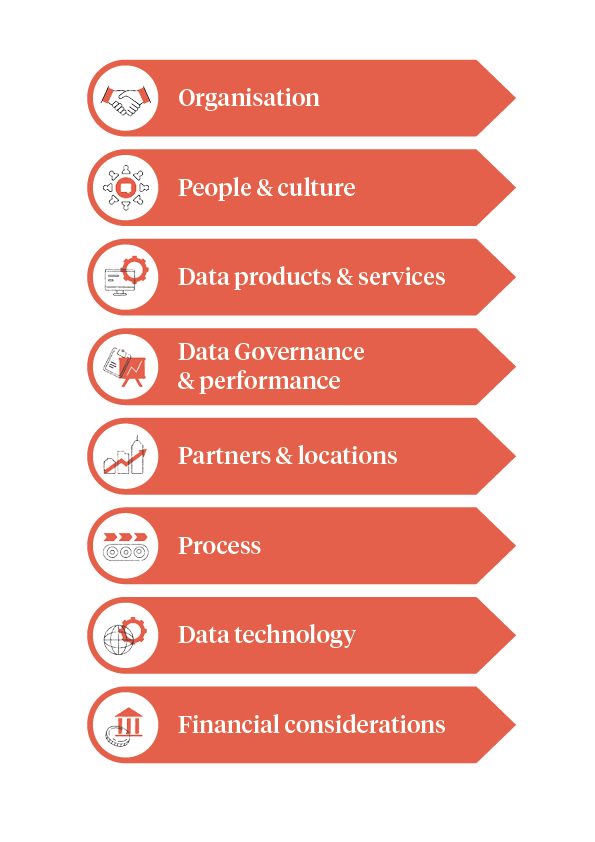
In this four-part series, we offer practical advice on how organisations can successfully realise value from data by running through the detail of our eight-layer data operating model.
In this first instalment, we address the first and second layers: ‘Organisation' and ‘People & Culture.' We will provide an overview of the challenges faced in these areas and explain the important factors to consider when designing and implementing your data operating model.
Every organisation captures data on their customers, products, services, the market, their finances, and more. However, only some organisations realise how to unlock the data they hold, delivering improved data efficiency, better analytical insights, and ultimately better business decision making. Read next: Transforming your organisation to succeed with data: Part two As organisations strive to achieve this, they often take on poorly thought out, siloed, and tactical approaches that raise operating costs and fall short of delivering the expected value. A technology-only approach is often adopted, which ignores the power of having strong teams with dedicated roles and a data culture that delivers what end-users actually require. Approach outline To achieve success with data, a holistic approach needs to be considered, making sure that the organisation is compatible with but doesn’t dictate the data product architecture. Additionally, whilst the selection of data technology to support the architecture is important, the skills and knowledge of the people required to deliver solutions using this technology should not be downplayed. A transformation that considers people, technology, and organisation together with a clear understanding of the potential pitfalls has the best chance of success. At the beginning of a data transformation programme, the organisation needs to design the outcomes carefully. This should establish a solid programme structure and define the vision, benefits, and outcomes with a clear understanding of the gap between current and future state. Ideally, the data transformation can be applied broadly and not benefit only a small group of individualistic teams. Ultimately, an organisation should be able to “roll-up” or virtualise their data so that it can be accessed across multiple technologies, old and new, to the benefit of many data consumers.

Organisation

Data operating models consider people and the way they communicate, from the data consumers, data producers and internal end-users to the external end-users and customers whose data the organisation holds. The architectural and organisational design needs to outline how individuals and teams interact with each other, and how technology enables these teams to realise value from data according to a clear strategy for the data itself.
Areas of focus include the Office of the CDO, governance councils and forums, data science and analyst communities of practice, as well as the teams developing data products and services across the organisation. Starting with the role and remit of the Office of the CDO, its purpose, and how it will achieve its agenda helps to define clear reporting lines and establish executive responsibility for data. Data governance forums enable the development and maintenance of data quality, policy, standards and procedures across the organisation, as well as authority levels, decision making, and issue escalation. As with any organisational change, there is likely to be some resistance where new roles and automated ways of working and technologies are being introduced. Bearing this in mind, strong communication of the strategy and programme vision from the start and successful roll-out across all members of the enterprise – not just those with data specific roles - is essential. The organisation needs to be engaged and prepared for the upcoming data changes and understand the benefits expected for the entire organisation. People & Culture

Being able to put your finger on an organisation’s culture and what drives certain behaviours is a difficult ask, whilst changing a culture and driving new behaviours is even more challenging. Starting out with a clear data vision and consideration of business needs with achievable goals will inspire the enterprise to get behind the new data operating model. A clear change plan based on a change impact assessment will support the transition. Having change champions, running drop-in sessions, distributing content across multiple communication channels, and encouraging team leaders to explain how change will impact their own teams will better equip an organisation to face the challenge. Within the data organisation, new data competencies that encompass skills, knowledge, and behaviours should be introduced to ensure that the organisation can clearly embed and maintain their practices. New roles including Data Steward, Data Domain Owner, Data Engineers, Data Scientists, Data Analysts, Data Quality Analysts, Data Product Owners, Metadata specialists and more will ensure that the organisation covers all of the key areas, with these key roles being put in place across each data domain. The purpose and responsibilities of these roles needs to be communicated beyond the data organisation so that individuals from across the organisation know who to contact for their specific data needs. Most organisations attempt to change behaviours through one-off interventions such as training, but this has its limitations and can quickly be forgotten. Behavioural change can occur through the introduction of new technologies, with new roles taking responsibility for new and existing processes. Technologies such as data management tooling, for example, allows the organisation to have a singular, clear data lexicon with well-defined terminology and common definitions. Shared source data catalogues increase visibility of the available data, helps identify gaps, and supports collaboration when determining how to unlock value from data. In a nutshell
A technology-only approach to data transformation is insufficient in any data transformation programme. Dedicated roles, an introduction of new data competencies, a shift in culture, and a clear vision that is clearly communicated across the organisation are key.
Don’t fall into the trap of just putting on some training; this can easily be forgotten and will not empower people to embrace the change. In our second blog of this series, we address layers three and four: ‘Data Products & Services’ and ‘Data Products.’
Contact Us
Let's talk!
We're ready to help turn your biggest challenges into your biggest advantages.
Searching for a new career?
View job openings